COM0004NFBNM: Numeracy, Data & IT - Portfolio of Solved Tasks
VerifiedAdded on 2023/06/18
|15
|2029
|479
Practical Assignment
AI Summary
This assignment solution covers various aspects of numeracy, data analysis, and IT skills, including basic numerical operations, ratios, percentages, and graphical techniques. It involves solving problems related to fractions, decimals, and data interpretation, as well as using spreadsheet applications like Excel for data recording, formula implementation, and statistical analysis. The solution demonstrates the application of functions like RANK, IF, SUM, VLOOKUP, MEDIAN, and AVERAGE for data manipulation and analysis. The assignment also discusses the importance of standard deviation in data analysis and provides detailed calculations and explanations for each question. Desklib offers a wide range of similar solved assignments and past papers to assist students in their studies.
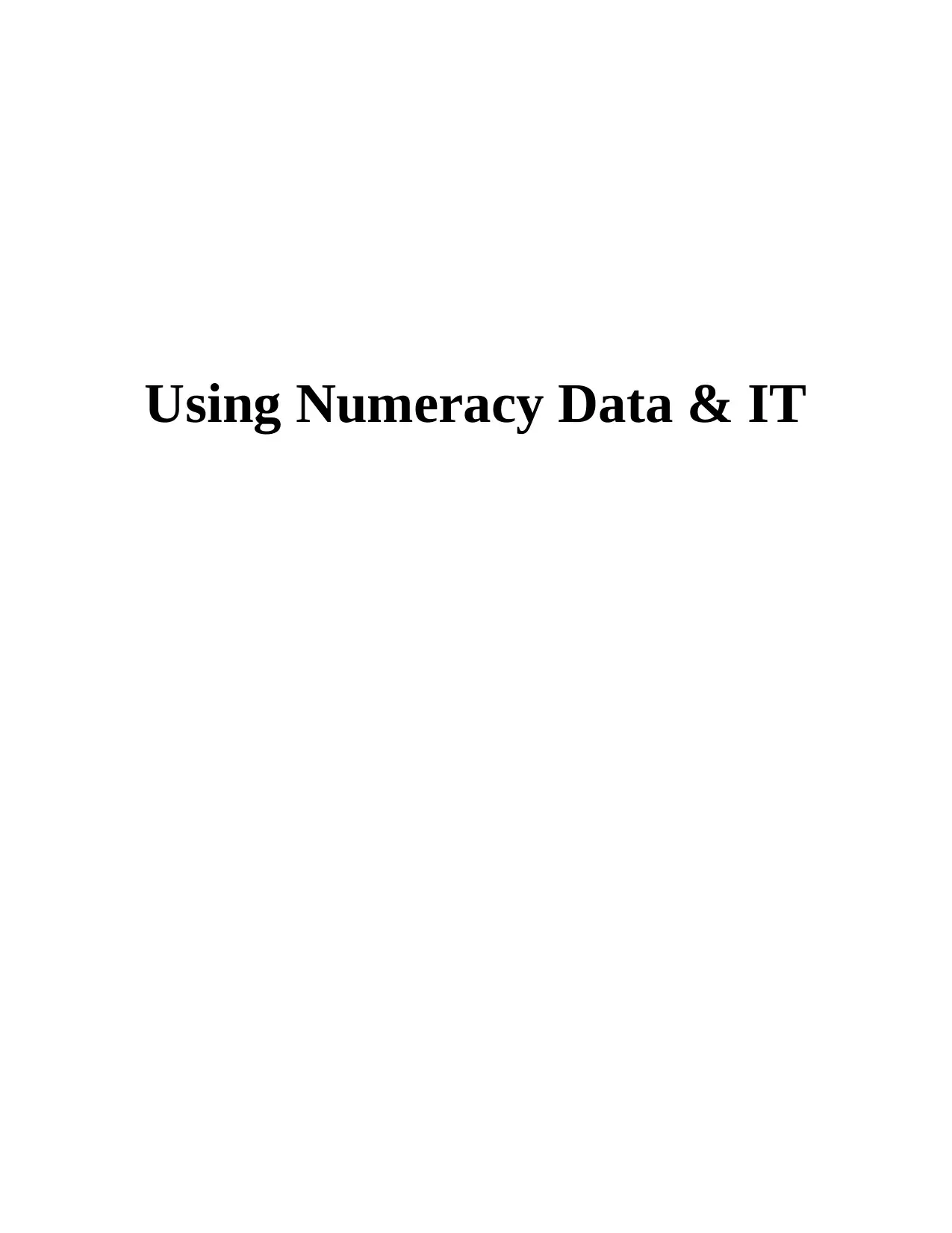
Using Numeracy Data & IT
Paraphrase This Document
Need a fresh take? Get an instant paraphrase of this document with our AI Paraphraser
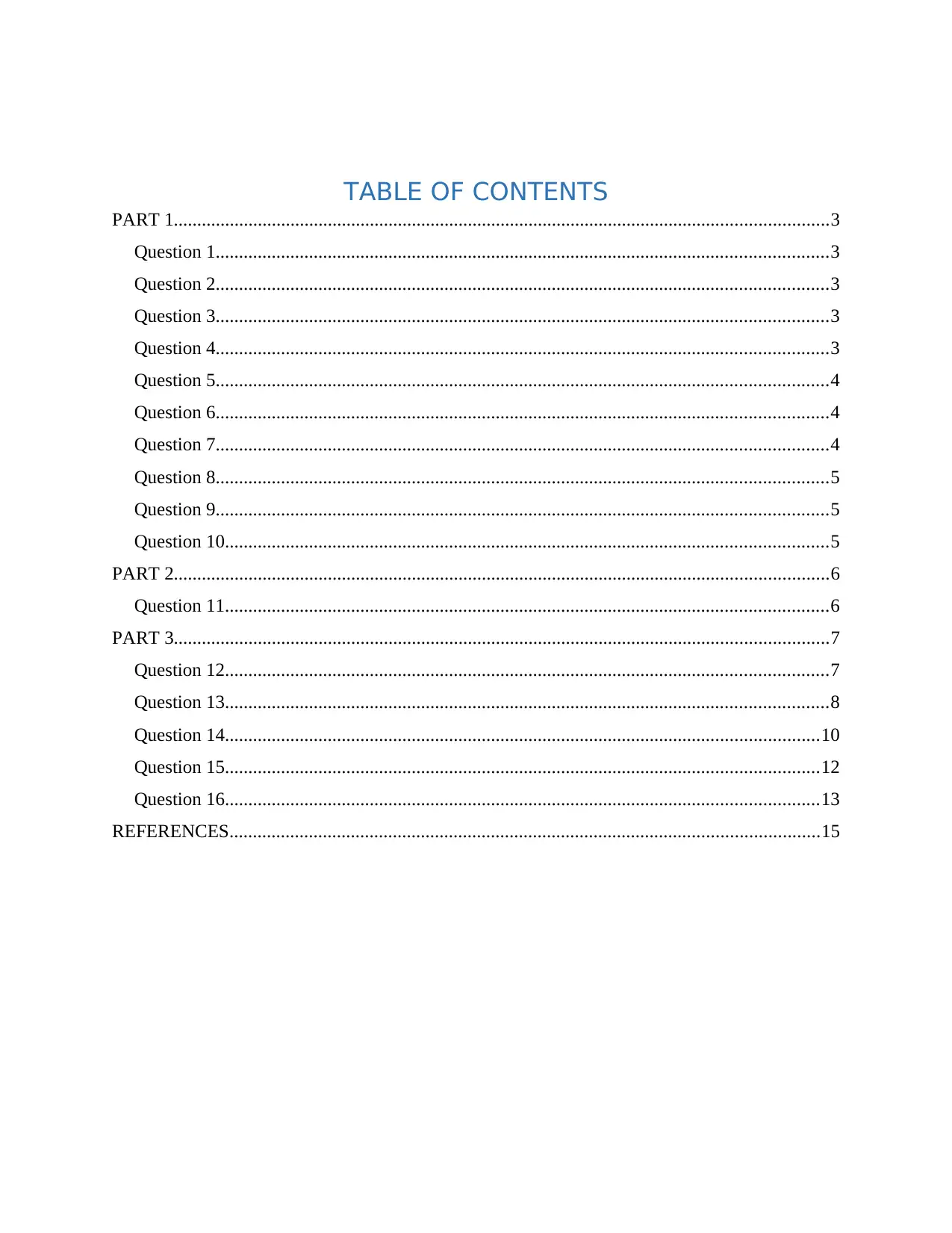
TABLE OF CONTENTS
PART 1............................................................................................................................................3
Question 1...................................................................................................................................3
Question 2...................................................................................................................................3
Question 3...................................................................................................................................3
Question 4...................................................................................................................................3
Question 5...................................................................................................................................4
Question 6...................................................................................................................................4
Question 7...................................................................................................................................4
Question 8...................................................................................................................................5
Question 9...................................................................................................................................5
Question 10.................................................................................................................................5
PART 2............................................................................................................................................6
Question 11.................................................................................................................................6
PART 3............................................................................................................................................7
Question 12.................................................................................................................................7
Question 13.................................................................................................................................8
Question 14...............................................................................................................................10
Question 15...............................................................................................................................12
Question 16...............................................................................................................................13
REFERENCES..............................................................................................................................15
PART 1............................................................................................................................................3
Question 1...................................................................................................................................3
Question 2...................................................................................................................................3
Question 3...................................................................................................................................3
Question 4...................................................................................................................................3
Question 5...................................................................................................................................4
Question 6...................................................................................................................................4
Question 7...................................................................................................................................4
Question 8...................................................................................................................................5
Question 9...................................................................................................................................5
Question 10.................................................................................................................................5
PART 2............................................................................................................................................6
Question 11.................................................................................................................................6
PART 3............................................................................................................................................7
Question 12.................................................................................................................................7
Question 13.................................................................................................................................8
Question 14...............................................................................................................................10
Question 15...............................................................................................................................12
Question 16...............................................................................................................................13
REFERENCES..............................................................................................................................15
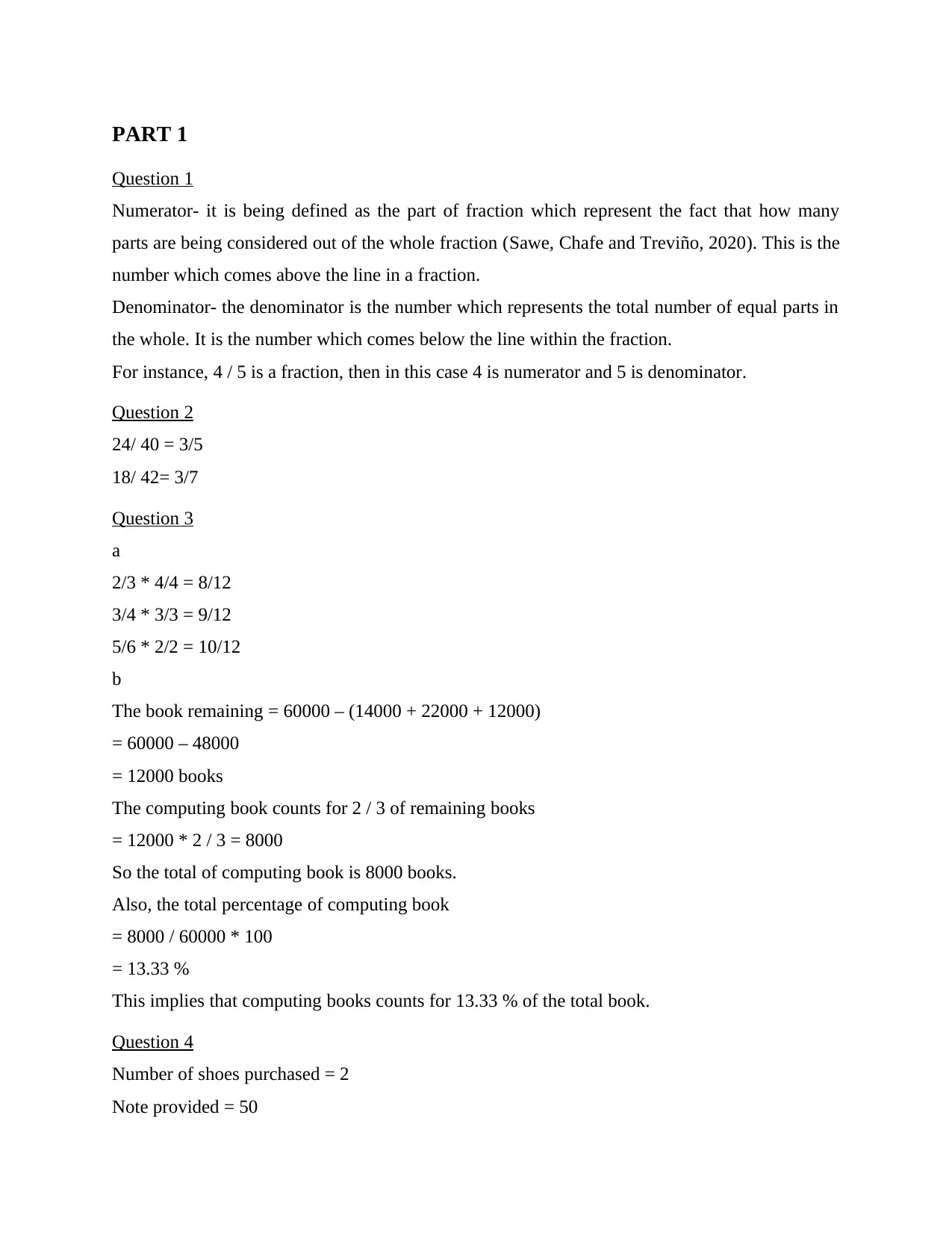
PART 1
Question 1
Numerator- it is being defined as the part of fraction which represent the fact that how many
parts are being considered out of the whole fraction (Sawe, Chafe and Treviño, 2020). This is the
number which comes above the line in a fraction.
Denominator- the denominator is the number which represents the total number of equal parts in
the whole. It is the number which comes below the line within the fraction.
For instance, 4 / 5 is a fraction, then in this case 4 is numerator and 5 is denominator.
Question 2
24/ 40 = 3/5
18/ 42= 3/7
Question 3
a
2/3 * 4/4 = 8/12
3/4 * 3/3 = 9/12
5/6 * 2/2 = 10/12
b
The book remaining = 60000 – (14000 + 22000 + 12000)
= 60000 – 48000
= 12000 books
The computing book counts for 2 / 3 of remaining books
= 12000 * 2 / 3 = 8000
So the total of computing book is 8000 books.
Also, the total percentage of computing book
= 8000 / 60000 * 100
= 13.33 %
This implies that computing books counts for 13.33 % of the total book.
Question 4
Number of shoes purchased = 2
Note provided = 50
Question 1
Numerator- it is being defined as the part of fraction which represent the fact that how many
parts are being considered out of the whole fraction (Sawe, Chafe and Treviño, 2020). This is the
number which comes above the line in a fraction.
Denominator- the denominator is the number which represents the total number of equal parts in
the whole. It is the number which comes below the line within the fraction.
For instance, 4 / 5 is a fraction, then in this case 4 is numerator and 5 is denominator.
Question 2
24/ 40 = 3/5
18/ 42= 3/7
Question 3
a
2/3 * 4/4 = 8/12
3/4 * 3/3 = 9/12
5/6 * 2/2 = 10/12
b
The book remaining = 60000 – (14000 + 22000 + 12000)
= 60000 – 48000
= 12000 books
The computing book counts for 2 / 3 of remaining books
= 12000 * 2 / 3 = 8000
So the total of computing book is 8000 books.
Also, the total percentage of computing book
= 8000 / 60000 * 100
= 13.33 %
This implies that computing books counts for 13.33 % of the total book.
Question 4
Number of shoes purchased = 2
Note provided = 50
⊘ This is a preview!⊘
Do you want full access?
Subscribe today to unlock all pages.

Trusted by 1+ million students worldwide

Total number of notes = 3
So total money provided = 50 * 3 = 150
Money returned by shopkeeper is 10.50
For calculation of price of both shoes = money paid – money received
= 150 – 10.50 = 139.50
Thus, the total money paid for pair of two shoes is 139.50
So price of one pair of shoe = 139.50 / 2
= 69.75
Question 5
A
240.50 * 19.54 = 6499.37
B
5.21* 10^4
Question 6
A
Total money paid by three siblings = 210
Total discount received = 30 %
Thus, this implies that 70 % payment is made which is 210.
So for 1 % = 210 / 70 = 3
For 100 % payment is 300
Thus, the total saving made is 300 – 210 = 90
B
Total saving done by each person = total saving / total number of people
= 90 / 3 = 30 per sibling
Question 7
A
Firstly, convert the fraction in simplest form which involves-
3/4 = 0.75
7/9 = 0.78
2/3 = 0.66
So total money provided = 50 * 3 = 150
Money returned by shopkeeper is 10.50
For calculation of price of both shoes = money paid – money received
= 150 – 10.50 = 139.50
Thus, the total money paid for pair of two shoes is 139.50
So price of one pair of shoe = 139.50 / 2
= 69.75
Question 5
A
240.50 * 19.54 = 6499.37
B
5.21* 10^4
Question 6
A
Total money paid by three siblings = 210
Total discount received = 30 %
Thus, this implies that 70 % payment is made which is 210.
So for 1 % = 210 / 70 = 3
For 100 % payment is 300
Thus, the total saving made is 300 – 210 = 90
B
Total saving done by each person = total saving / total number of people
= 90 / 3 = 30 per sibling
Question 7
A
Firstly, convert the fraction in simplest form which involves-
3/4 = 0.75
7/9 = 0.78
2/3 = 0.66
Paraphrase This Document
Need a fresh take? Get an instant paraphrase of this document with our AI Paraphraser
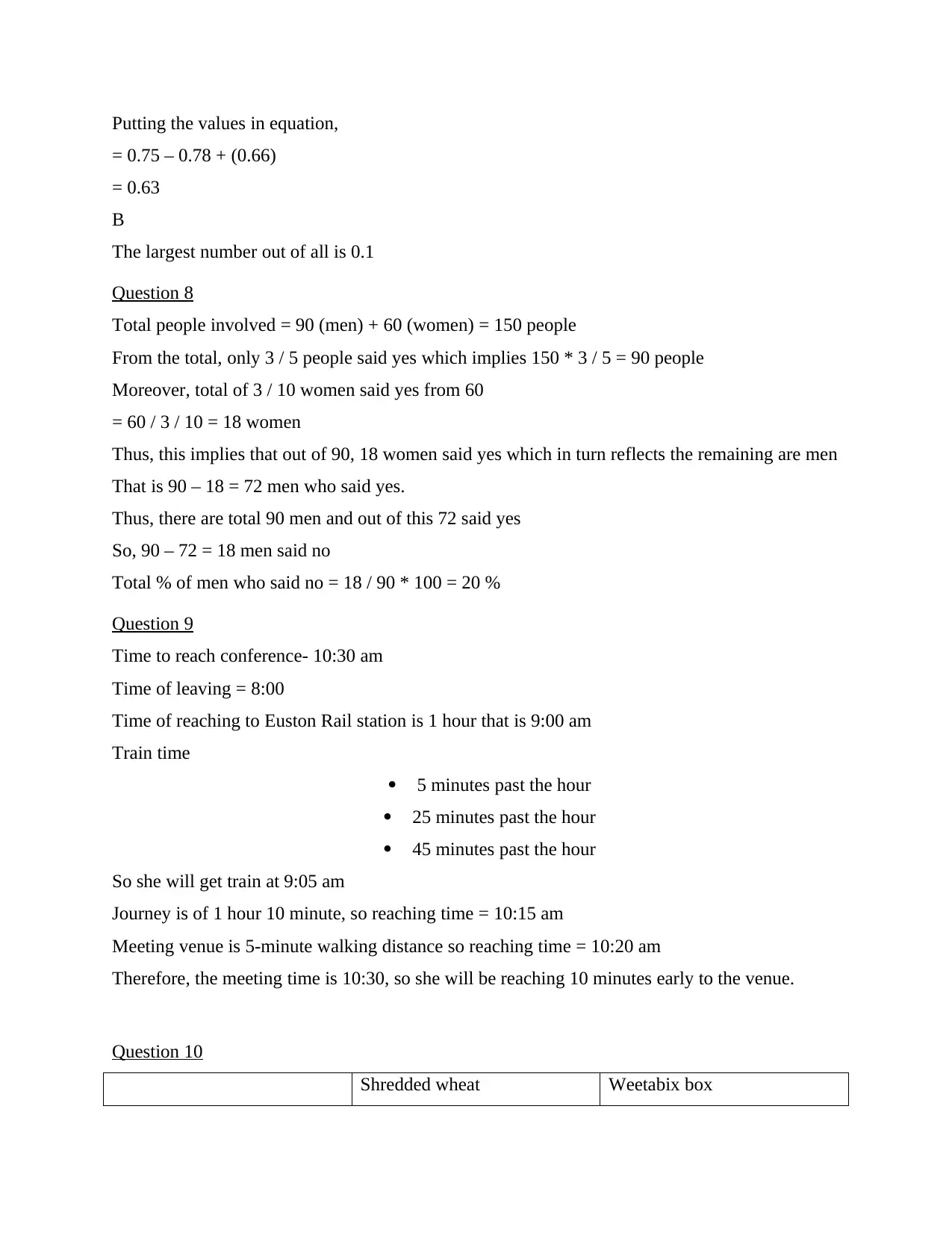
Putting the values in equation,
= 0.75 – 0.78 + (0.66)
= 0.63
B
The largest number out of all is 0.1
Question 8
Total people involved = 90 (men) + 60 (women) = 150 people
From the total, only 3 / 5 people said yes which implies 150 * 3 / 5 = 90 people
Moreover, total of 3 / 10 women said yes from 60
= 60 / 3 / 10 = 18 women
Thus, this implies that out of 90, 18 women said yes which in turn reflects the remaining are men
That is 90 – 18 = 72 men who said yes.
Thus, there are total 90 men and out of this 72 said yes
So, 90 – 72 = 18 men said no
Total % of men who said no = 18 / 90 * 100 = 20 %
Question 9
Time to reach conference- 10:30 am
Time of leaving = 8:00
Time of reaching to Euston Rail station is 1 hour that is 9:00 am
Train time
5 minutes past the hour
25 minutes past the hour
45 minutes past the hour
So she will get train at 9:05 am
Journey is of 1 hour 10 minute, so reaching time = 10:15 am
Meeting venue is 5-minute walking distance so reaching time = 10:20 am
Therefore, the meeting time is 10:30, so she will be reaching 10 minutes early to the venue.
Question 10
Shredded wheat Weetabix box
= 0.75 – 0.78 + (0.66)
= 0.63
B
The largest number out of all is 0.1
Question 8
Total people involved = 90 (men) + 60 (women) = 150 people
From the total, only 3 / 5 people said yes which implies 150 * 3 / 5 = 90 people
Moreover, total of 3 / 10 women said yes from 60
= 60 / 3 / 10 = 18 women
Thus, this implies that out of 90, 18 women said yes which in turn reflects the remaining are men
That is 90 – 18 = 72 men who said yes.
Thus, there are total 90 men and out of this 72 said yes
So, 90 – 72 = 18 men said no
Total % of men who said no = 18 / 90 * 100 = 20 %
Question 9
Time to reach conference- 10:30 am
Time of leaving = 8:00
Time of reaching to Euston Rail station is 1 hour that is 9:00 am
Train time
5 minutes past the hour
25 minutes past the hour
45 minutes past the hour
So she will get train at 9:05 am
Journey is of 1 hour 10 minute, so reaching time = 10:15 am
Meeting venue is 5-minute walking distance so reaching time = 10:20 am
Therefore, the meeting time is 10:30, so she will be reaching 10 minutes early to the venue.
Question 10
Shredded wheat Weetabix box
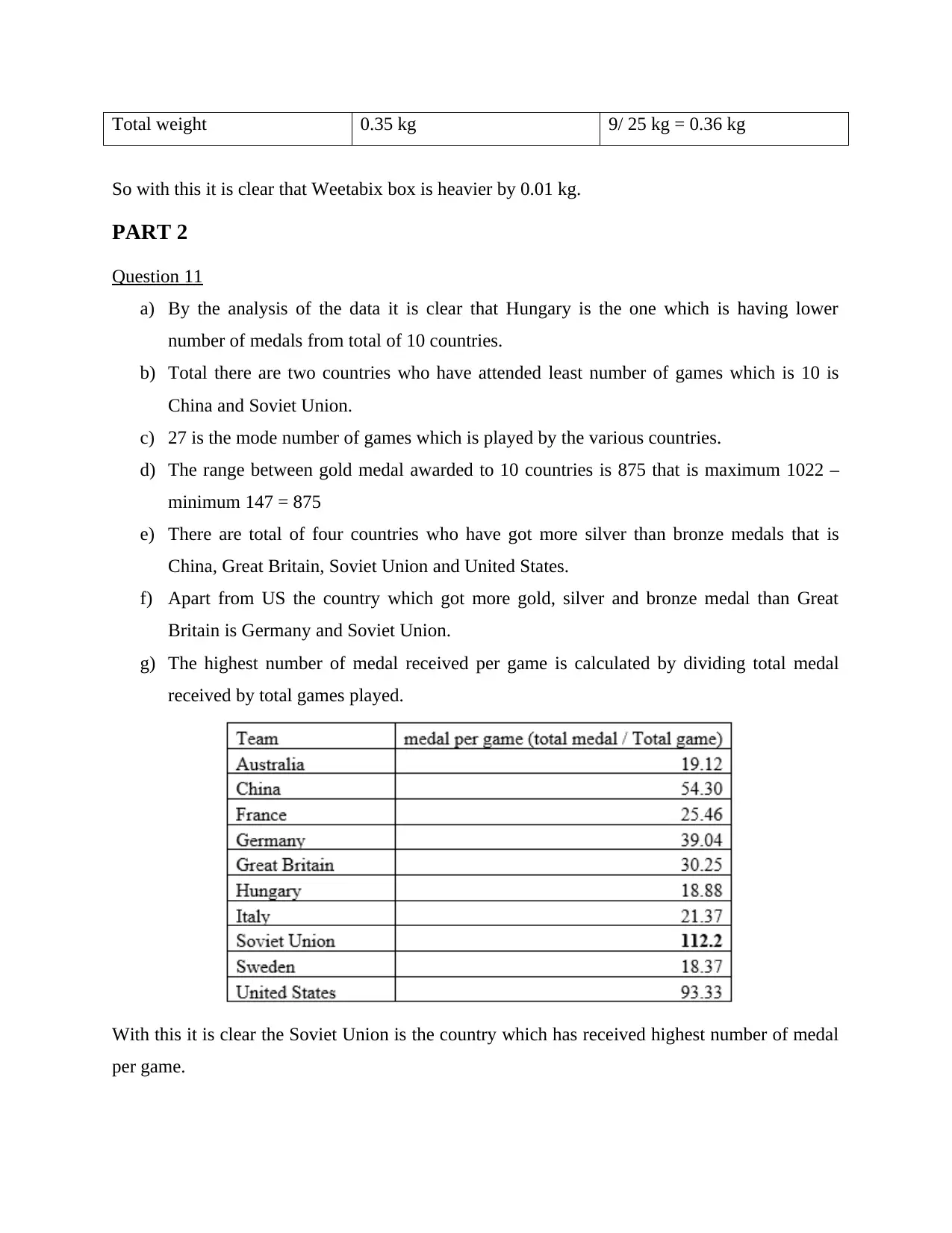
Total weight 0.35 kg 9/ 25 kg = 0.36 kg
So with this it is clear that Weetabix box is heavier by 0.01 kg.
PART 2
Question 11
a) By the analysis of the data it is clear that Hungary is the one which is having lower
number of medals from total of 10 countries.
b) Total there are two countries who have attended least number of games which is 10 is
China and Soviet Union.
c) 27 is the mode number of games which is played by the various countries.
d) The range between gold medal awarded to 10 countries is 875 that is maximum 1022 –
minimum 147 = 875
e) There are total of four countries who have got more silver than bronze medals that is
China, Great Britain, Soviet Union and United States.
f) Apart from US the country which got more gold, silver and bronze medal than Great
Britain is Germany and Soviet Union.
g) The highest number of medal received per game is calculated by dividing total medal
received by total games played.
With this it is clear the Soviet Union is the country which has received highest number of medal
per game.
So with this it is clear that Weetabix box is heavier by 0.01 kg.
PART 2
Question 11
a) By the analysis of the data it is clear that Hungary is the one which is having lower
number of medals from total of 10 countries.
b) Total there are two countries who have attended least number of games which is 10 is
China and Soviet Union.
c) 27 is the mode number of games which is played by the various countries.
d) The range between gold medal awarded to 10 countries is 875 that is maximum 1022 –
minimum 147 = 875
e) There are total of four countries who have got more silver than bronze medals that is
China, Great Britain, Soviet Union and United States.
f) Apart from US the country which got more gold, silver and bronze medal than Great
Britain is Germany and Soviet Union.
g) The highest number of medal received per game is calculated by dividing total medal
received by total games played.
With this it is clear the Soviet Union is the country which has received highest number of medal
per game.
⊘ This is a preview!⊘
Do you want full access?
Subscribe today to unlock all pages.

Trusted by 1+ million students worldwide
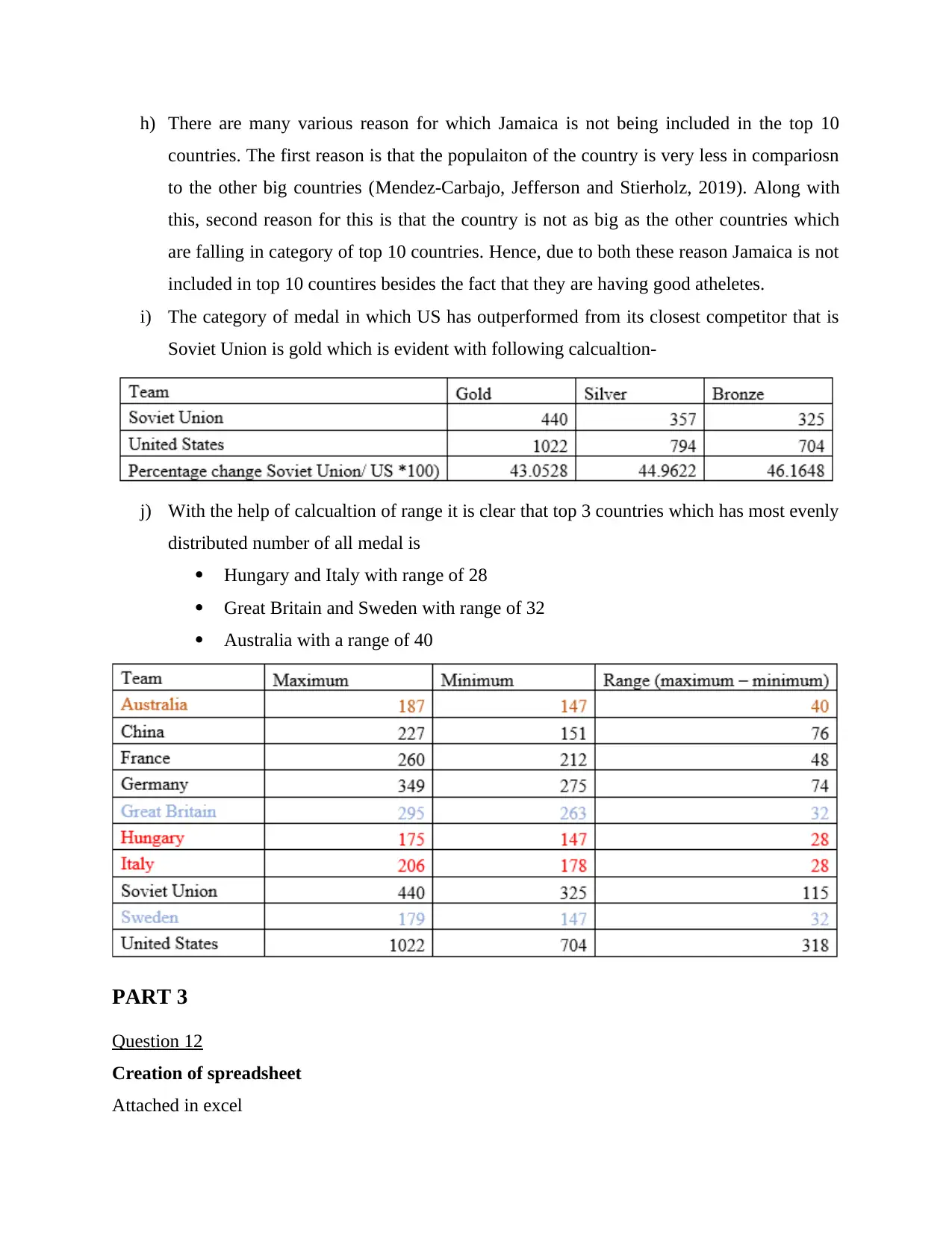
h) There are many various reason for which Jamaica is not being included in the top 10
countries. The first reason is that the populaiton of the country is very less in compariosn
to the other big countries (Mendez-Carbajo, Jefferson and Stierholz, 2019). Along with
this, second reason for this is that the country is not as big as the other countries which
are falling in category of top 10 countries. Hence, due to both these reason Jamaica is not
included in top 10 countires besides the fact that they are having good atheletes.
i) The category of medal in which US has outperformed from its closest competitor that is
Soviet Union is gold which is evident with following calcualtion-
j) With the help of calcualtion of range it is clear that top 3 countries which has most evenly
distributed number of all medal is
Hungary and Italy with range of 28
Great Britain and Sweden with range of 32
Australia with a range of 40
PART 3
Question 12
Creation of spreadsheet
Attached in excel
countries. The first reason is that the populaiton of the country is very less in compariosn
to the other big countries (Mendez-Carbajo, Jefferson and Stierholz, 2019). Along with
this, second reason for this is that the country is not as big as the other countries which
are falling in category of top 10 countries. Hence, due to both these reason Jamaica is not
included in top 10 countires besides the fact that they are having good atheletes.
i) The category of medal in which US has outperformed from its closest competitor that is
Soviet Union is gold which is evident with following calcualtion-
j) With the help of calcualtion of range it is clear that top 3 countries which has most evenly
distributed number of all medal is
Hungary and Italy with range of 28
Great Britain and Sweden with range of 32
Australia with a range of 40
PART 3
Question 12
Creation of spreadsheet
Attached in excel
Paraphrase This Document
Need a fresh take? Get an instant paraphrase of this document with our AI Paraphraser
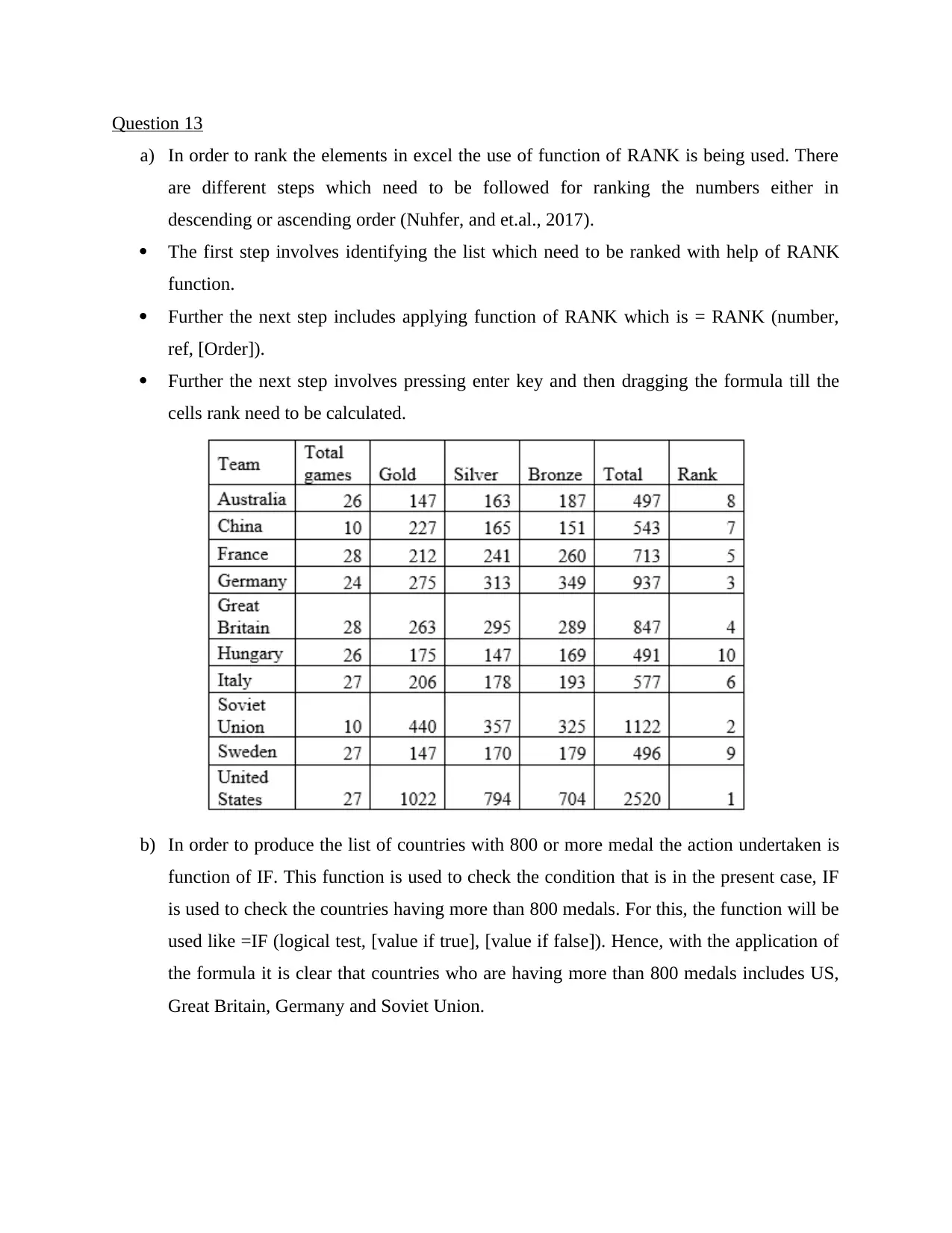
Question 13
a) In order to rank the elements in excel the use of function of RANK is being used. There
are different steps which need to be followed for ranking the numbers either in
descending or ascending order (Nuhfer, and et.al., 2017).
The first step involves identifying the list which need to be ranked with help of RANK
function.
Further the next step includes applying function of RANK which is = RANK (number,
ref, [Order]).
Further the next step involves pressing enter key and then dragging the formula till the
cells rank need to be calculated.
b) In order to produce the list of countries with 800 or more medal the action undertaken is
function of IF. This function is used to check the condition that is in the present case, IF
is used to check the countries having more than 800 medals. For this, the function will be
used like =IF (logical test, [value if true], [value if false]). Hence, with the application of
the formula it is clear that countries who are having more than 800 medals includes US,
Great Britain, Germany and Soviet Union.
a) In order to rank the elements in excel the use of function of RANK is being used. There
are different steps which need to be followed for ranking the numbers either in
descending or ascending order (Nuhfer, and et.al., 2017).
The first step involves identifying the list which need to be ranked with help of RANK
function.
Further the next step includes applying function of RANK which is = RANK (number,
ref, [Order]).
Further the next step involves pressing enter key and then dragging the formula till the
cells rank need to be calculated.
b) In order to produce the list of countries with 800 or more medal the action undertaken is
function of IF. This function is used to check the condition that is in the present case, IF
is used to check the countries having more than 800 medals. For this, the function will be
used like =IF (logical test, [value if true], [value if false]). Hence, with the application of
the formula it is clear that countries who are having more than 800 medals includes US,
Great Britain, Germany and Soviet Union.
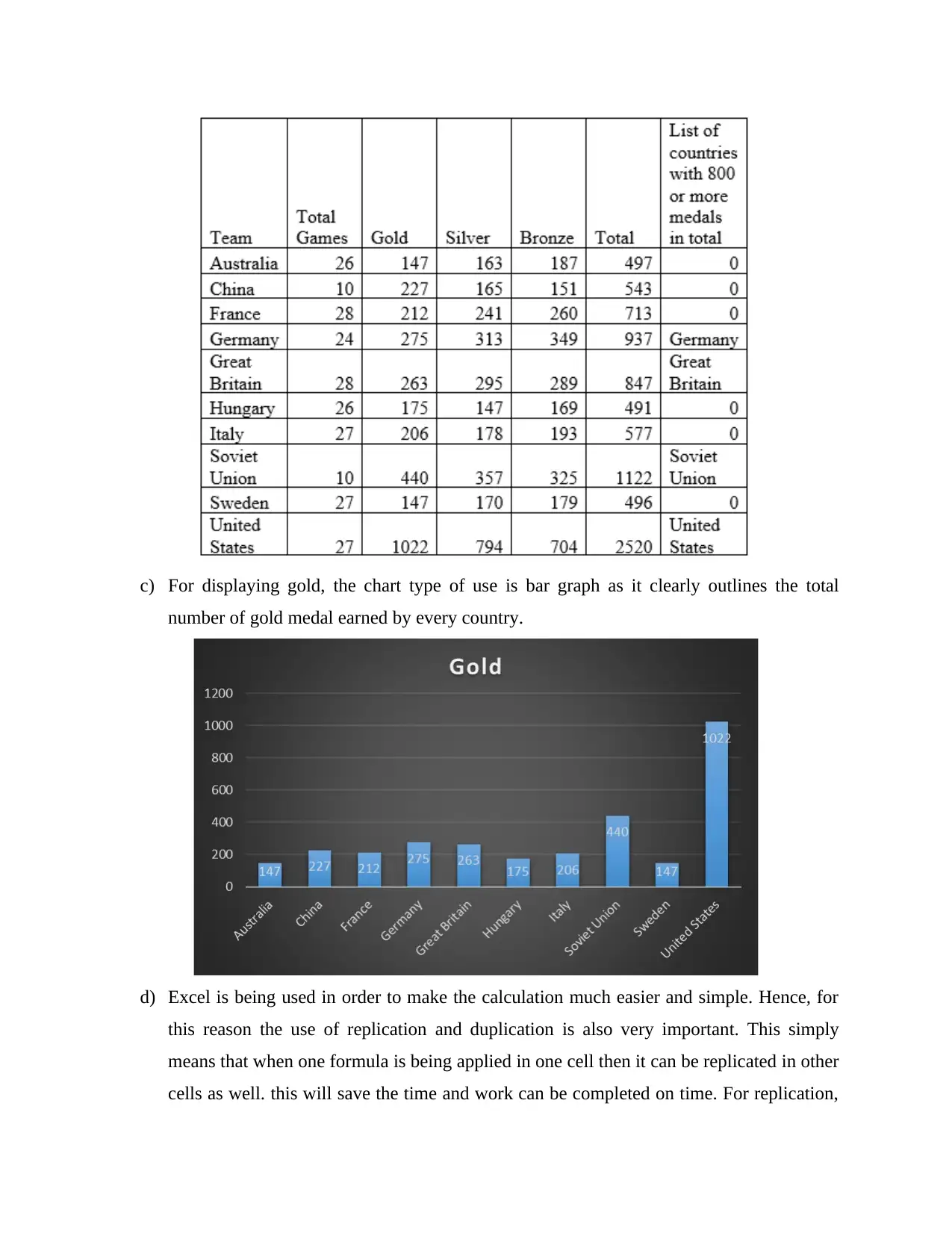
c) For displaying gold, the chart type of use is bar graph as it clearly outlines the total
number of gold medal earned by every country.
d) Excel is being used in order to make the calculation much easier and simple. Hence, for
this reason the use of replication and duplication is also very important. This simply
means that when one formula is being applied in one cell then it can be replicated in other
cells as well. this will save the time and work can be completed on time. For replication,
number of gold medal earned by every country.
d) Excel is being used in order to make the calculation much easier and simple. Hence, for
this reason the use of replication and duplication is also very important. This simply
means that when one formula is being applied in one cell then it can be replicated in other
cells as well. this will save the time and work can be completed on time. For replication,
⊘ This is a preview!⊘
Do you want full access?
Subscribe today to unlock all pages.

Trusted by 1+ million students worldwide
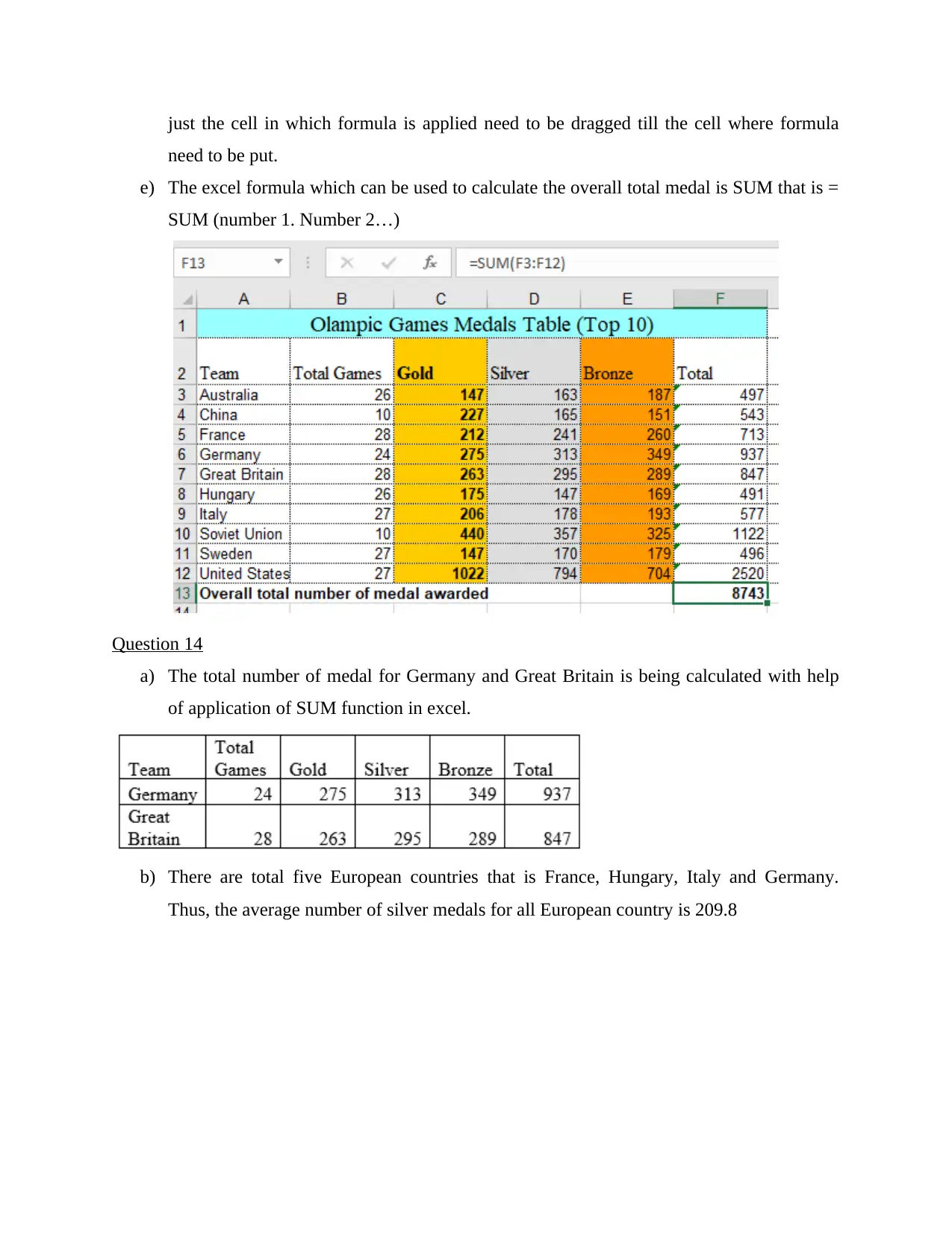
just the cell in which formula is applied need to be dragged till the cell where formula
need to be put.
e) The excel formula which can be used to calculate the overall total medal is SUM that is =
SUM (number 1. Number 2…)
Question 14
a) The total number of medal for Germany and Great Britain is being calculated with help
of application of SUM function in excel.
b) There are total five European countries that is France, Hungary, Italy and Germany.
Thus, the average number of silver medals for all European country is 209.8
need to be put.
e) The excel formula which can be used to calculate the overall total medal is SUM that is =
SUM (number 1. Number 2…)
Question 14
a) The total number of medal for Germany and Great Britain is being calculated with help
of application of SUM function in excel.
b) There are total five European countries that is France, Hungary, Italy and Germany.
Thus, the average number of silver medals for all European country is 209.8
Paraphrase This Document
Need a fresh take? Get an instant paraphrase of this document with our AI Paraphraser
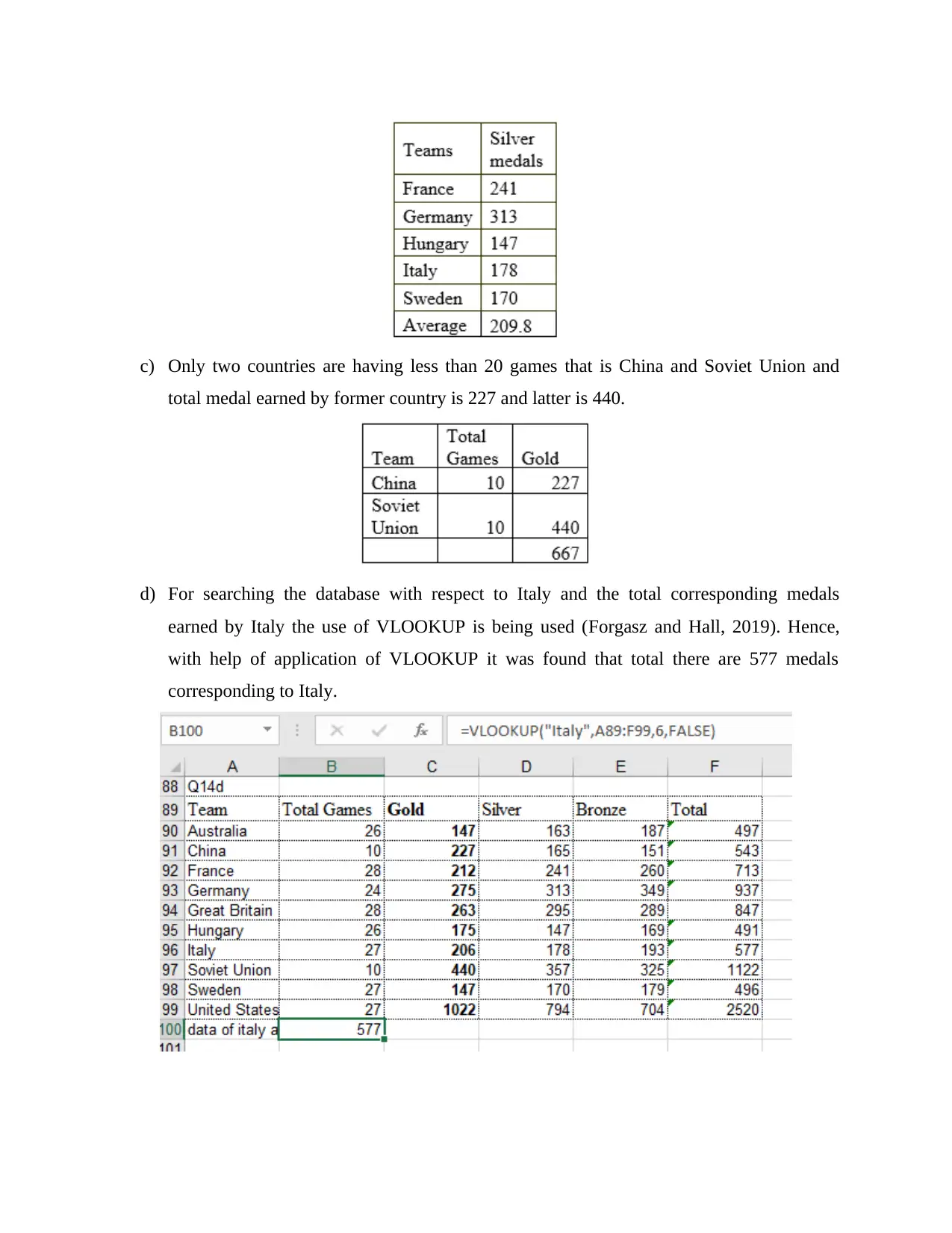
c) Only two countries are having less than 20 games that is China and Soviet Union and
total medal earned by former country is 227 and latter is 440.
d) For searching the database with respect to Italy and the total corresponding medals
earned by Italy the use of VLOOKUP is being used (Forgasz and Hall, 2019). Hence,
with help of application of VLOOKUP it was found that total there are 577 medals
corresponding to Italy.
total medal earned by former country is 227 and latter is 440.
d) For searching the database with respect to Italy and the total corresponding medals
earned by Italy the use of VLOOKUP is being used (Forgasz and Hall, 2019). Hence,
with help of application of VLOOKUP it was found that total there are 577 medals
corresponding to Italy.

Question 15
a) For the calculation of median number of medals for each type of medal that is gold, silver
and bronze use of median formula will be undertaken. This is applied like =MEDIAN
(data range).
b) Further for the calculation of means number of medal for every category of medal the use
of formula of = AVERAGE (data range) will be used.
c)
d) The standard deviation is very useful in order to analyse the data in proper and effective
manner. This function of standard deviation is useful in order to calculate the dispersion
of the data from the mean. Hence, this outlines the number which assist the researcher in
measuring that in a group how much deviation is present from the mean value. In the
a) For the calculation of median number of medals for each type of medal that is gold, silver
and bronze use of median formula will be undertaken. This is applied like =MEDIAN
(data range).
b) Further for the calculation of means number of medal for every category of medal the use
of formula of = AVERAGE (data range) will be used.
c)
d) The standard deviation is very useful in order to analyse the data in proper and effective
manner. This function of standard deviation is useful in order to calculate the dispersion
of the data from the mean. Hence, this outlines the number which assist the researcher in
measuring that in a group how much deviation is present from the mean value. In the
⊘ This is a preview!⊘
Do you want full access?
Subscribe today to unlock all pages.

Trusted by 1+ million students worldwide
1 out of 15
Related Documents
Your All-in-One AI-Powered Toolkit for Academic Success.
+13062052269
info@desklib.com
Available 24*7 on WhatsApp / Email
![[object Object]](/_next/static/media/star-bottom.7253800d.svg)
Unlock your academic potential
Copyright © 2020–2025 A2Z Services. All Rights Reserved. Developed and managed by ZUCOL.


